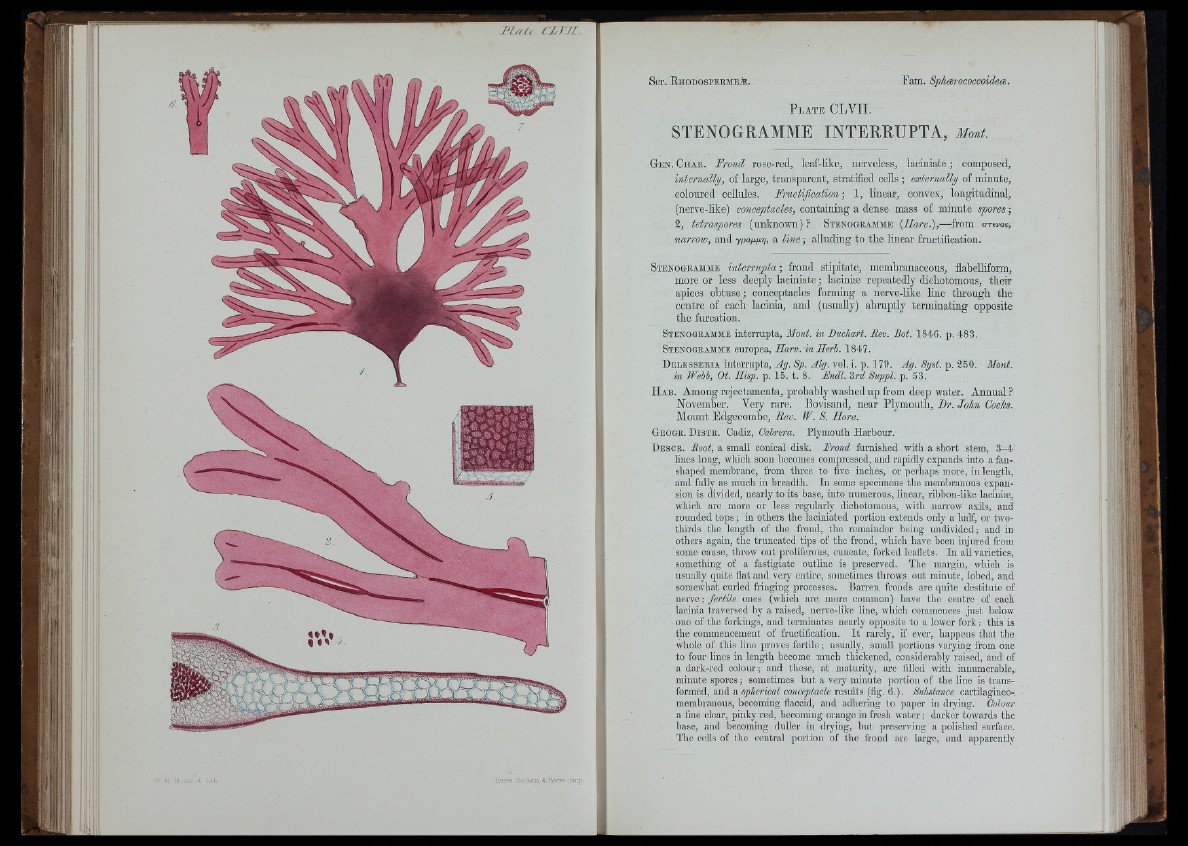
P ! r j ( , r i r j i .
h. H G.-.1 el .lii.h Reeve,Beiiha.ni&Reeve .imp-
P l a t e C L V I I .
STENO GRAMME INTERRUPTA, Mont.
Gen. Ch a u . Frond rose-red, leaf-like, nerveless, la c in ia te ; composed,
mternalhj, of large, transparent, stratified cells ; externally of minute,
coloured cellules. Fructification-, 1, linear, convex, longitudinal,
(nerve-Mke) conceptaoles, containing a dense mass of minute spores;
3, tetraspores (unknown) ? Stenogeammb (Harv.),—from a-rcvos,
narrow, and ypaggr), a lin e ; alluding to th e linear fructification.
Stenogeamme inierrvpta-, frond stipitate, membranaceous, flabelliform,
more or less deeply laciniate ; laciniæ repeatedly dicliotomous, their
apices obtuse ; conceptacles forming a nerve-like line through the
centre of each lacinia, and (usually) abruptly terminating opposite
th e furcation.
Stenogeamme interrapta, Mont. in Luclmrt. Rev. Bot. 1846. p. 483.
Stenogeamme europea, Harv. in Herb. 1847.
D e l e s s e e i a inteiTupta, Ag. Sp. Alg. vol. i. p. 179. Ag. Syst. p. 350. Mont.
in Webb, Ot. Hisp. p. 15. t. 8. Endl. 3rd Suppl. p. 53.
H a b . Among rejectamenta, probably washed up from deep water. Annual ?
November. Very rare. Bovisand, near Plymouth, Dr. John Cocks.
Mount Edgecombe, Rev. W. S. Hore.
G eoge. D is t e . Cadiz, Gabrera. Plymouth Harhour.
D e sc e . Root, a small conical disk. Erond furnished with a short stem, 3 -4
lines long, wliich soon becomes compressed, and rapidly expands into a fanshaped
membrane, from three to five inches, or perhaps more, in length,
and fuUy as much in breadth. In some specimens the membranous expansion
is divided, nearly to its base, into numerous, linear, ribbon-like laciniæ,
which are more or less regularly dicliotomous, witb narrow axils, and
rounded tops ; in others the laciniated portion extends only a half, or two-
thirds the length of the frond, the remainder being undivided ; and in
others again, the truncated tips of the frond, which have been injured from
some cause, throw out proliferous, cuneate, forked leaflets. In aU varieties,
something of a fastigiate outline is preserved. The margin, which is
usually quite flat and very entire, sometimes throws out minute, lobed, and
somewhat curled fringing
nerve ; fertile ones (whic
irocesses. Barren fronds are quite destitute of
ch are more common) have the centre of each
lacinia traversed by a raised, nerve-like line, which commences just below
one of tbe forkings, and terminates nearly opposite to a lower fork: this is
the commencement of fructification. I t rarely, if ever, happens that the
whole of this line proves fertile; usually, small portions varying from one
to four lines in length become much thickened, considerably raised, and of
a dark-red colom'; and these, at maturity, are filled with innumerable,
minute spores; sometimes but a very minute portion of the Une is transformed,
and a spherical coneeptacle results (fig. 6.). Substance cartilagineo-
membranous, becoming flaccid, and adhering to paper in diying. Colour
a fine clear, pinky red, becoming orange iu fresh water; dai’ker towards the
base, and becoming duller in drying, but preserving a polished surface.
The cells of the central portion of the frond are large, and apparently
ft
It'' ' 1
I 1